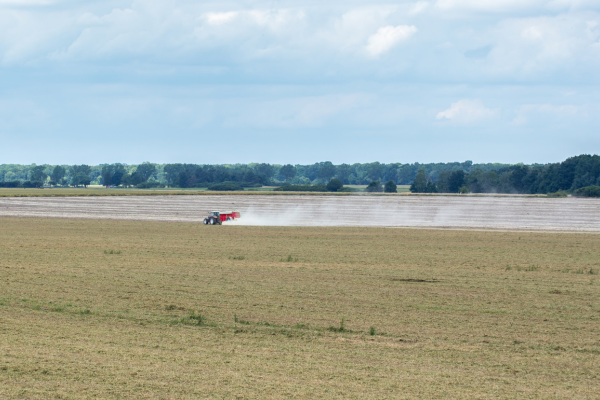
Liming and Soil pH
What Determines Soil pH?
Over time and years of crop production, soil pH tends to decrease. Some course textured soil types (sand) are naturally low in organic matter and pH. Every fall/winter, we hear a lot about where your soil pH should be for your cropping practices. They bring these points into the conversation in order for you to realize what your pH should be for your crop next season to utilize available nutrients to the fullest. Soil liming is generally a fall practice, however, it can continue into the winter.
Several factors determine the pH of soil. The parent material from which the soil was formed is one of the most important. For instance, soils formed from sandstone or shale are more acidic than soils formed from more basic parent material like limestone. Nutrient leaching from high levels of rainfall/irrigation will leach out basic elements like Calcium and Magnesium over time. These are replaced by more acidic elements like H+ and aluminum. Also, the pH of rainwater is about 5.6 due to the reaction with CO2 in the atmosphere. Soil pH’s lower than this are considered to be acid rain and result from pollution sources such as sulfur dioxide and nitrous oxides generated from the burning of fossil fuels. Thus, soils formed in humid, high rainfall conditions are usually acidic, while arid soils are more alkaline.
Crop production and harvesting removes nutrients such as calcium and magnesium, causing soils to acidify. Soil depth also influences acidity. With the exception of arid areas, acidity increases with soil depth. Therefore, eroded soils tend to be more acidic than non-eroded. Nitrogen, through the conversion of ammonium to nitrate in the process called nitrification, released H+, which acidifies the soil. Nitrogen from fertilizer, decomposing organic matter, manure, and N fixation all produce acidity. Each pound of N requires 1-2 lbs of lime to neutralize the acidity.
Liming Materials Increase pH
Soil pH is a measure of the hydrogen ion (H+) concentration in the soil. It consists of 2 parts, the H+ in the soil solution and the exchangeable H+ which depends on the CEC (cation exchange capacity) of the soil. The optimum soil pH varies with individual crops and soil types (In Nebraska, Corn 6.5-6.8, Soybeans 6.8-7.0). The most common liming materials used to raise the pH in acid soils contain calcium carbonate or calcium and magnesium carbonate (called dolomitic lime). Other types of liming material include Quicklime or calcium oxide CaO, slaked lime or calcium hydroxide Ca(OH)2, marl, and various slags.
Liming materials must consist of an alkaline cation and a negatively charged anion which will react with the displaced H+ from the exchange sites. Calcium Hydroxide, Ca(OH)2, or Hydrated Lime also neutralizes acidity, but without the production of CO2. All liming forms act similarly in that exchangeable H+ is replaced and converted to water, with an increase in the base saturation of the soil. However, all liming materials are not equal in their ability to neutralize acidity. The effectiveness of a liming material is called the effect of calcium carbonate equivalent. Calcium carbonate has a Calcium Carbonate Equivalence (CCE) of 100, and other liming materials are compared to that. The other factor affecting the rate the liming material will react with the soil is the fineness of the liming material. The finer limestone is ground, the faster it will react.

Excess Lime, Alkali, and Salinity1
Most Nebraska soils originally contained free lime and the underlying parent material from which the soils formed still does. Over a long period of time, with sufficient rainfall, the free or excess lime is removed from the topsoil to depths of as much as 6 feet. However, on some upland slopes, erosion has occurred more rapidly than the downward movement of lime. Consequently, those surface soils still contain free lime. In river valleys, alluvial (water-carried) deposits have continued, which causes some soils to contain free lime at the surface. Iron chlorosis in susceptible plants (soybeans and sorghum) is common on soils containing excess lime and selection of tolerant crops or varieties may be necessary.
Frequently, on high lime soils, higher application rates of fertilizer (phosphorus and zinc) are necessary to provide adequate nutrients for crop growth. A pH above 7 indicates that the soil is alkaline. Soils containing free lime normally range from pH 7.3 to 8.3. Soils containing excess exchangeable sodium, called alkali, often have pH values up to 10.0. Saline soils are those that contain excessive amounts of sodium, calcium, magnesium, and potassium salts. Soils containing excess exchangeable sodium and salts are called saline-alkali. Additional tests are necessary to classify these soils for treatment. The tests needed are conductivity to determine the total salt content and exchangeable sodium to determine the extent of the alkali problem. Saline-alkali soils may or may not contain excess lime. Recommendations for managing these problem soils will be included with saline-alkali soil test reports.
References
1. Frank, K.D. , Knudsen, D. 1992 Nebraska Cooperative Ext. Pub. G92-1096.
Dr. John McNamara // Wilbur-Ellis Agronomist


